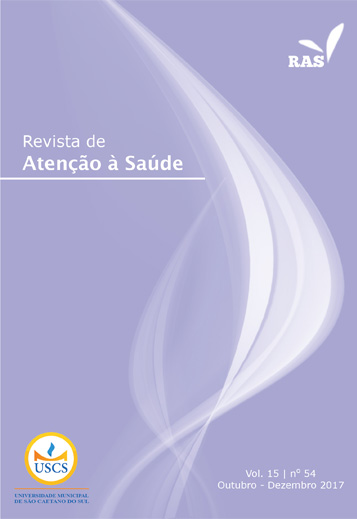BODY COMPOSITION AND HANDGRIP STRENGTH IN ELDERLY WOMEN WHO ARE PHISICALLY ACTIVE IN UNIATI UNIEVANGÉLICA PROGRAM
DOI:
https://doi.org/10.13037/ras.vol15n54.4583Keywords:
Body composition, hand strength, elderlyAbstract
Introduction and objectives: Changes in body composition may interfere in the physical functionality of elderly. The objective of this study is to measure the nutritional state and the handgrip strength in physically active elderlies who practice rhythm activity. Materials and methods: The sample was composed of 31 elderly women; the body composition was measured by tetrapolar electrical bioimpedance and the handgrip strength was measured by Jamar dynamometer. The analyses were performed in groups of women with different ages (? 68 and > 68 years), in those with adequate muscle mass index (IMMa > 6.75 kg/m2) and in those with insufficient muscle mass index (IMMi ? 6.75 kg/m2). The differences between the groups were measured by Student’s t-test, for independent samples, while the correlations were measured by the Pearson’s test. Results and conclusion: Body composition has showed that 43.8% of elderly had excessive body fat and 64% had adequate muscle mass. Those older than 68 years old have showed significant reduction of body mass (p = 0.014) and of body mass index (BMI, p = 0.025). The handgrip strength was considered adequate in 77%, regarding the right member, and in 99% when considering the left member. Correlations between handgrip strength and body composition have not been identified. Finally, it was concluded that the analyzed women had adequate handgrip strength and satisfactory lean body mass, the majority of them, but they have showed unsatisfactory percentage of fat mass, which requires interventions to change the profile of adiposity of such samples.
Downloads
References
World Health Organization. World report on ageing and health. Geneva: WHO; 2015 [citado em 2017 nov 7]. 260 p. Disponível em: https://goo.gl/1iXuwF
World Health Organization. Multisectoral action for a life course approach to healthy ageing: draft global strategy and plan of action on ageing and health. Sixty-Ninth World Health Assembly A69/17 [Internet]. 2016 [citado em 2017 nov 7]. 37 p. Disponível em: https://goo.gl/cDm5TS
Brasil. Instituto Brasileiro de Geografia e Estatística. Projeção da população do Brasil por sexo e idade para o período 2000/2060 [Internet]. Rio de Janeiro: IBGE; 2013 [citado em 2017 nov 7]. Disponível em: https://goo.gl/xQqtA1
Rodrigues MAP, Facchini LA, Piccini RX, Tomasi E, Thumé E, Silveira DS, et al. Uso de serviços básicos de saúde por idosos portadores de condições crônicas, Brasil. Rev Saude Publica [Internet]. 2009 [citado em 2017 nov 7];43(4):604-12. Disponível em: https://goo.gl/hvYPgf
Gobbo LA, Dourado DAQS, Almeida MF, Duarte YAO, Lebrão ML, Marucci MFN. Massa muscular de idosos do município de São Paulo – Estudo SABE: Saúde, Bem-estar e Envelhecimento. Rev Bras Cineantropom Desempenho Hum. 2012;14(1):1-10.
McKay MJ, Baldwin JN, Ferreira P, Simic M, Vanicek N, Burns J; 1000 Norms Project Consortium. Normative reference values for strength and flexibility of 1,000 children and adults. Neurology. 2017;88(1):36-43.
Greenway KG, Walkley JW, Rich PA. Relationships between self-reported lifetime physical activity, estimates of current physical fitness, and aBMD in adult premenopausal women. Arch Osteoporos. 2015;10(1):e34.
Taekema DG, Gussekloo J, Maier AB, Westendorp RGJ, de Craen AJM. Handgrip strength as a predictor of functional, psychological and social health. A prospective population-based study among the oldest old. Age Ageing. 2010;39(3):331-7.
Rijk JM, Roos PR, Deckx L, van den Akker M, Buntinx F. Prognostic value of handgrip strength in people aged 60 years and older: A systematic review and meta-analysis. Geriatr Gerontol Int. 2016;16(1):5-20.
Sallinen J, Stenholm S, Rantanen T, Heliövaara M, Sainio P, Koskinen S. Hand-grip strength cut-points to screen older persons at risk for mobility limitation. J Am Geriatr Soc. 2010;58(9):1721-6.
Silva Neto LS, Karnikowiski MGO, Tavares AB, Lima RM. Associação entre sarcopenia, obesidade sarcopênica e força muscular com variáveis relacionadas de qualidade de vida em idosas. Rev Bras Fisioter. 2012;16(5):360-7.
Choi KM. Sarcopenia and sarcopenic obesity. Korean J Intern Med. 2016:31(6):1054-60.
Janssen I, Baumgartner RN, Ross R, Rosenberg IH, Roubenoff R. Skeletal muscle cutpoints associated with elevated physical disability risk in older men and women. Am J Epidemiol. 2004;159(4):413-21.
Newman AB, Haggerty CL, Goodpaster B, Harris T, Kritchevsky S, Nevitt M, et al.; Health Aging and Body Composition Research Group. Strength and muscle quality in a well-functioning cohort of older adults: the Health, Aging and Body Composition Study. J Am Geriatr Soc. 2003;51(3):323-30.
World Health Organization. Obesity: preventing and managing the global epidemic. Report of a WHO Consultation (WHO Technical Report Series 894). Geneva: WHO; 2000. 252 p.
Kyle UG, Bosaeus I, De Lorenzo AD, Deurenberg P, Elia M, Gómez JM, et al. Bioelectrical impedance analysis – part I: review of principles and methods. Clin Nutr. 2004;23(5):1226-43.
Lee RC, Wang Z, Heo M, Ross R, Janssen I, Heymsfield SB. Total-body skeletal muscle mass: development and cross-validation of anthropometric prediction models. Am J Clin Nutr 2000;72(3):796-803
Janssen I. The epidemiology of sarcopenia. Clin Geriatr Med. 2011;27(3):355-63.
Fess EE. Grip strength. In: Casanova JS, editor. Clinical assessment recommendations. 2nd ed. Chicago: American Society of Hand Therapists; 1992. p. 41-5.
D’oliveira GDF. Análise do perfil da força de preensão palmar em idosas no Distrito Federal [Tese]. Brasília, DF: Universidade Católica de Brasília; 2010.
Brasil. Ministério da Saúde. DATASUS [Internet]. SISVAN – Notas Técnicas. 2007 [citado em 2017 nov 7]. Disponível em: https://goo.gl/FMh8ST
Marques APO, Arruda IKG, Espírito Santo ACG, Raposo MCF, Guerra MD, Sales TF. Prevalência de obesidade e fatores associados em mulheres idosas. Arq Bras Endocrinol Metab. 2005;49(3):441-8.
Tinoco ALA, Brito LF, Sant’Anna MSL, Abreu WC, Mello AC, Silva MMS, et al. Sobrepeso e obesidade medidos pelo índice de massa corporal (IMC), circunferência da cintura (CC) e relação cintura/quadril (RCQ) de idosos da Zona da Mata Mineira. Rev Bras Geriatr Gerontol. 2006;9(2):63-73.
Flegal KM, Shepherd JA, Looker AC, Graubard BI, Borrud LG, Ogden CL, et al. Comparisons of percentage body fat, body mass index, waist circumference and waist-stature ratio in adults. Am J Clin Nutr. 2009;89(2):500-8.
Andrade AN, Fernandes MGM, Nóbrega MML, Garcia TR, Costa KNFM. Análise do conceito fragilidade em idosos. Texto contexto enferm. 2012;21(4):748-56.
Bergman H, Béland F, Feightner J, Fernie G, Hébert R, Hogan D, et al. The Canadian initiative on frailty and aging. Aging Clin Exp Res. 2003;15(3):1-8.
Gadelha AB, Dutra MT, de Oliveira RJ, Safons MP, Lima RM. Associação entre força, sarcopenia e obesidade sarcopénica com o desempenho funcional de idosas. Motri. 2014;10(3):31-9.
Lopez P, Radaelli R, Rech A, Wilhelm EN, Pinto RS. Muscle quality, but not muscle thickness, is decreased in different age groups of active older women. Rev Bras Cineantropom. desempenho hum. 2015 [citado em 2017 nov 7];17(3):347-56. Disponível em: https://goo.gl/ZuT3D6
Martinez BP, Ramos IR, Oliveira QC, Santos RA, Marques MD, Forgiarini Júnior LA, et al. Is there is an association between mass and skeletal muscle strength in hospitalized elderly persons? Rev Bras Geriatr Gerontol. 2016;19(2):257-64.
Carneiro JAO, Almeida DS, Vilaça KHC, Pfrimer K, Santos-Pontelli TEG, Carneiro AAO, et al. Influência da obesidade e da força de preensão palmar no equilíbrio postural estático de idosas ativas. Motriz: rev. educ. fis. 2012 [citado em 2017 nov 7];18(3):432-40. Disponível em: https://goo.gl/8JpYK8
Virtuoso JF, Balbé GP, Hermes JM, Amorim Júnior EE, Fortunato AR, Mazo GZ. Força de preensão manual e aptidões físicas: um estudo preditivo com idosos ativos. Rev Bras Geriatr Gerontol. 2014 [citado em 2017 nov 7];17(4):775-84. Disponível em: https://goo.gl/irQX7u
Mattioli RA, Cavalli AS, Ribeiro JAB, Silva MC. Associação entre força de preensão manual e atividade física em idosos hipertensos. Rev Bras Geriatr Gerontol. 2015;18(4):881-91
Lenardt MH, Binotto MA, Carneiro NHK, Cechinel C, Betiolli SE, Lourenço TM. Força de preensão manual e atividade física em idosos fragilizados. Rev Esc Enferm USP. 2016;50(1):86-92.
Garcia PA, Dias JMD, Rocha ASS, Almeida NC, Macedo OG, Dias RC. Relação da capacidade funcional, força e massa muscular de idosas com osteopenia e osteoporose. Fisioter Pesqui. 2015;22(2):126-32.
Cawthon PM. Assessment of lean mass and physical performance in sarcopenia. J Clin Densitom. 2015;18(4):467-71.
Rava A, Pihlak A, Ereline J, Gapeyeva H, Kums T, Purge P, Pääsuke, M. Body composition, neuromuscular performance, and mobility: comparison between regularly exercising and inactive older women. J Aging Phys Act. 2017;25(1):58-64.
Lee WJ, Peng LN, Chiou ST, Chen LK. Physical health indicators improve prediction of cardiovascular and all-cause mortality among middle-aged and older people: a national population-based study. Sci Rep. 2017;7:e40427.
Stessman J, Rottenberg Y, Fischer M, Hammerman-Rozenberg A, Jacobs JM. handgrip strength in old and very old adults: mood, cognition, function, and mortality. J Am Geriatr Soc. 2017;65(3):526-32.
de Souza Barbosa JF, Zepeda MUP, Béland F, Guralnik JM, Zunzunegui MV, Guerra RO. Clinically relevant weakness in diverse populations of older adults participating in the International Mobility in Aging Study. Age (Dordr). 2016;38(1):e25.
Downloads
Published
Issue
Section
License
Policy Proposal for Journals offering Free Delayed Access
Authors who publish in this magazine agree to the following terms:
- Authors maintain the copyright and grant the journal the right to the first publication, with the work simultaneously licensed under a Creative Commons Attribution License after publication, allowing the sharing of the work with recognition of the authorship of the work and initial publication in this journal.
- Authors are authorized to assume additional contracts separately, for non-exclusive distribution of the version of the work published in this magazine (eg, publishing in institutional repository or as a book chapter), with the acknowledgment of the authorship and initial publication in this journal.
- Authors are allowed and encouraged to publish and distribute their work online (eg in institutional repositories or on their personal page) at any point before or during the editorial process, as this can generate productive changes, as well as increase impact and citation of the published work (See The Effect of Open Access).









